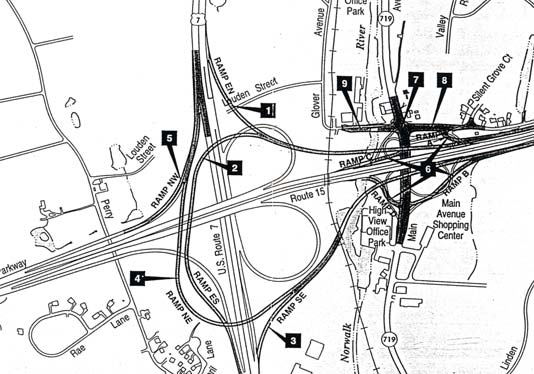Updated Oct 20, 2018


The Merritt Parkway (state route 15), built in 1938, serves east-west auto traffic in Fairfield County. The US 7 freeway, first proposed in the 1950s, crosses the Merritt Parkway in Norwalk. Although the US 7 freeway will never reach Danbury as envisioned, it was extended north of the Merritt in 1992, with an incomplete interchange built.
Work to complete this interchange began in 2005, but was halted soon afterward and not resumed.
The state planned two related improvement projects here: adding flyover ramps to complete the freeway connection at US 7, and modernizing the obsolete cloverleaf at Main Avenue (former US 7). Work was started in 2005, but halted by a U.S. District Court decision in March 2006.
Doing any major work on the Merritt Parkway requires some sensitivity, to balance traffic and safety needs against the history and scenery of the Parkway. (Similar conflicts arose over interchanges at the Route 8 and Route 25 freeways.)
The overall $98 million project was broken out into two phases. The first phase, to modernize the Main Avenue interchange and prepare for 7/15, started in April 2005. The second phase, to complete the 7/15 interchange, was originally to begin in 2007.
 The state's plan to add flyover ramps to the 7/15 interchange, and modify the cloverleaf at Main Ave (former US 7). From the Draft Federal Environmental Assessment, section 4(F) evaluation, Dec. 1992.
The state's plan to add flyover ramps to the 7/15 interchange, and modify the cloverleaf at Main Ave (former US 7). From the Draft Federal Environmental Assessment, section 4(F) evaluation, Dec. 1992.
The interchange at Main Avenue (former US 7) and the Merritt Parkway was the first cloverleaf in Connecticut. It's not symmetric by any means, but does have the requisite four loop ramps. As was customary when exit numbers were assigned in the 1940s, this interchange is both exits 39 and 40 on the Parkway.
When detailed designs for the US 7 freeway first surfaced, the proposed interchange with the Merritt Parkway was a four-level stack; a design criticized by many for being out of scale with the parkway. (At the same time—1960s and early 1970s—there was talk of widening the parkway to eight lanes; those interested in preserving the parkway's look were understandably wary of any large interchange proposals.)
I don't yet have details on how and when the state arrived at the interchange built in 1992. It's one half of a cloverleaf, providing full access to US 7 to and from the New York direction on the Merritt Parkway. Traffic to and from points north on the parkway must exit at Main Avenue and find their way to US 7 from there. Funding constraints might have been a reason for staging the construction in two parts.
At the end of 1992, the state had arrived at a proposed design for the remainder of the interchange. Instead of more loop ramps, semidirectional flyovers would be used, leading to an interchange with two different characters. Slight modifications would be made to the WS and NW ramps to accommodate the flyover ramps.
The cloverleaf at Main Avenue would be dismantled and replaced with a four-ramp diamond interchange. This design provides greater safety and reflects the decreased traffic role of former US 7.
The stated benefits of the 7/15 interchange design included connectivity between the two highways, and decreased traffic and accidents on Main Avenue.
In April 2005, shortly before the first phase of construction was to begin, the Merritt Parkway Conservancy proposed alternative designs for the 7/15 interchange. Both would do away with the flyover ramps of the ConnDOT design. The group's alternatives:
The Convervancy claimed that not only was the ConnDOT design expensive and injurious to the Parkway's landscape, but parts of it were unnecessary. For example, a new ramp leading from the Merritt Parkway to US 7 north would carry motorists to a freeway that would end only a mile later.
Unless, of course, there were plans afoot to resurrect the full US 7 freeway plan, alleged some residents and advocates. ConnDOT says this is not the case; at an April 1 public hearing, a deputy commissioner said the DOT has no such plans (and it would take 20 years of paperwork to get it started.)
Supporters of the ConnDOT design accused the Conservancy of simply wanting to kill the project, noting how long it takes for a proposal to even get to the point of being ready for bid.
Amid disputes on both sides, project phase 1 of the ConnDOT design went to bid in April 2005 as scheduled.